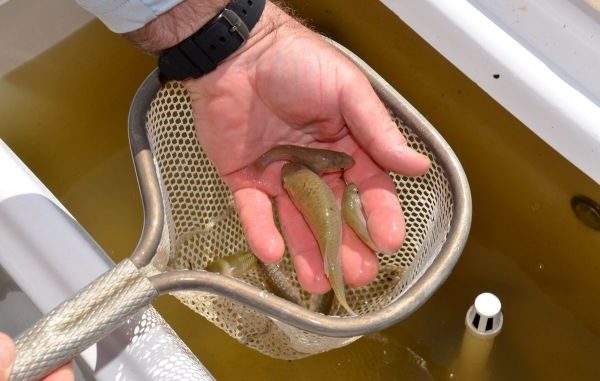
“I’m all about live bait,” veteran redfish and speckled trout charter guide Herk Bergeron said. “The catch ratio is much better with live bait, especially for bigger fish. Most of the winter, I use cocahoe minnows. I start with shrimp in April. From mid-May into August I use mostly croakers. In September, I shift back to cocahoes.
“I prefer to use croakers on trout because I mainly target bigger fish — 2 to 4 pounds.”
Bridge Side Marina owner Buggie Vegas pointed out that artificials will work for specks, but there’s a caveat.
“You can catch two trout at a time on sparkle beetles,” Vegas said, “but they are school trout, 10 to 14 inches.”
Bergeron agreed, adding that most fishermen want to catch larger fish.
“When people get something that knocks the rod out of their hands, they get a kick out of that,” he said.
The subject of live bait really got Vegas’ attention. He spends a lot of his time as a marina operator finding, tending and selling live bait.
He has his pet peeves.
“People will buy live bait, put it in a bucket, then stop and talk to people or go get coffee and let the bait sit in the bucket,” Vegas said. “You can get away with some of that with cocahoes; they are tough and will live in your pocket.
“But with shrimp and croakers, you can’t do any of that.
He said keeping the less-hardy bait alive requires attention to details.
“You need to have your live bait well cleaned and ready,” he said. “If people knew how hard we work to keep bait alive, they would appreciate it more. It’s more than just money for us: It’s taking pride in what you do.
“We spend many sleepless nights taking care of bait.”
Some fishermen’s habits leave Vegas and Bergeron shaking their heads.
One of the worst is when anglers dip a net full of bait from the well, select the one they want to use and then leave the net across the lip of the well, with the remaining bait suspended out of the water.
And, of course, using a dip net is important because sunscreen on anglers’ hands can stress or even kill bait.
“Also, don’t play with the bait,” Bergeron growled. “Dip your bait and get out of the tank.”
Livewell management is a high priority. Although shrimp and cocahoes can handle very low salinities, fresh water can kill croakers.
Aeration (not just recirculation) of livewell water can help. Bergeron’s boat is equipped with air intakes to add air to the water being moved by the recirculating pump.
And if you are going where you can’t run an open pump and it is in the heat of the summer, Vegas noted, some people put closed plastic containers of ice in their wells. You can use ice too, added Bergeron, but you have to be real careful: A large amount will change the temperature dramatically and kill the bait.
Vegas stressed that it is best not to mix baits in the same tanks.
“Shrimp and croakers will live, but if you are on a croaker bite, chasing them around with a net in a crowded tank will stress the shrimp,” Vegas said. “Whatever you do, don’t mix cocahoes and shrimp. The coahoes will pick at the shrimp, and eat the legs and eyes off of them.”
That’s a death sentence for the latter.
“If a shrimp ain’t got legs, it’s going to die,” Bergeron said.
Both men agreed on the need to remove dead bait. If the bait is to be held overnight, it should be checked before going to bed, and all weak swimmers should be discarded.
“I tell people that if they look at you wrong throw them out,” Vegas chuckled.
Above all, Vegas said people should never to cut back on their bait.
“Some people come in a $50,000 boat and spend $500 on lodging and food,” he shook his head. “Then they buy two dozen live baits.”
